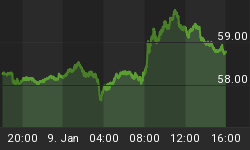US$ Fundamentals
The long-term fundamentals for the US$ are very bearish and boil down to the following:
a) The US runs a massive current account deficit
b) Due to high debt levels throughout the US economy and a stock market that is priced for perfection, future real returns on investment will be sub-par and the US will therefore be unable to attract enough new foreign investment to offset the current account deficit.
The combination of a) and b) above all but guarantee that the dollar's long-term trend will remain down until the current account deficit has been eliminated or until the prices of dollar-denominated investments become low by historical valuation standards.
It is always, however, possible for any market to move counter to its long-term fundamentals for an extended period (one year or even longer). Therefore, market participants should not rule-out the possibility that the dollar will embark on a substantial rebound at some point over the next few months.
Something that has the potential to cause a change in the dollar's intermediate-term trend is a change in the spread between the short-term US$ interest rate and the short-term euro interest rate, either as a result of the Fed hiking rates or the ECB lowering rates. This is because a change in the interest-rate spread, or even the anticipation of a change in the interest-rate spread, would prompt large players in the currency and debt markets to begin unwinding their dollar-carry trades. (An example of a dollar carry trade is borrowing dollars then exchanging the dollars for euros and investing the proceeds in higher-yielding euro-denominated debt; the result being a short-dollar/long-euro position that benefits from the relatively higher euro interest rate and the upward trend in EUR/USD).
The thing with carry trades is that they are self-reinforcing in one direction while they are being 'put on' and then self-reinforcing in the opposite direction while they are being closed out. In the case of the dollar-euro carry trade, for example, large bets have been made based on an expectation that the US$ interest rate will remain below the euro interest rate and that the US$ will continue to weaken relative to the euro; and these bets have, in turn, caused the US$ to become weaker than it would otherwise have been. However, if expectations change and these trades start being unwound there will be considerable upward pressure on the US$.
Two things that US$ bears continue to have in their favour, though, are that the US Administration does not want the dollar to strengthen prior to the November-2004 elections and the Fed will almost certainly not hike US interest rates until it is forced to do so by the bond market. The US Administration probably won't get its wish (the dollar will probably be above its current level by the time the elections roll around), but the Fed's first rate hike is being pushed out in time by the upward drift in the bond market. Furthermore, the ECB would be unlikely to lower euro interest rates unless the euro moved to new highs because doing so would risk creating a bigger inflation problem in Europe.
Commodities in non-US$ terms
In terms of the euro and other relatively strong currencies commodity prices have been a lot more docile, over the past few years, than they have been in US$ terms. Or, to put it another way, a lot of the strength we have recently seen in the CRB Index has been a result of US$ weakness as opposed to 'real' strength in commodities. This is not something that has escaped our attention and neither has it been a surprise to us since anticipated US$ weakness was one of the main reasons we went on record, during the dark days of Q4 2001, as saying that commodity prices were about to embark on a large multi-year rally.
The response of the commodity markets to a weakening US$ over the past two years is not materially different from what happened during the 1970s. In fact, we can't think of a reason why there would ever be a huge, broad-based, multi-year rally in commodity prices if not for inflation and its effects on the relative values of the fiat currencies. For instance, if the US$ were as good as gold then the long-term chart of the CRB Index would, we think, approximate a horizontal line with a few minor oscillations. As an aside, a chart of the CRB/gold ratio covering the past 30 years does not approximate a horizontal line; but that's because the price of gold, under the current monetary system, tends to experience disproportionately large swings in both directions in response to changes in confidence.
Further to the above, if it is reasonable to assume that the US$ is in a long-term bear market then it is equally reasonable to assume that US$-denominated commodity prices are immersed in a long-term bull market. Also, taking note of how US$ inflation has affected US$ commodity prices it is reasonable to assume that commodity prices are eventually going to move much higher against all the currencies that have been, and continue to be, inflated at rapid rates. In other words, against all the major fiat currencies since they are all experiencing rampant inflation. After all and as explained at TSI many times over the past 3 years, when the supply of money increases at a rapid rate over an extended period it is axiomatic that prices will rise somewhere in the economy. The only thing we need concern ourselves with is which prices.















